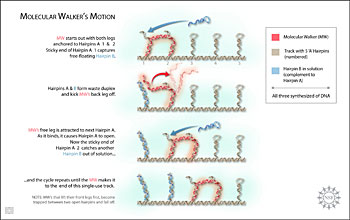News Release 08-008
Molecular Walker Takes Baby Steps
Locomotion of two-legged DNA walker holds promise for molecular machines

A molecular walker moves autonomously down a molecular track with five anchor sites.
January 17, 2008
This material is available primarily for archival purposes. Telephone numbers or other contact information may be out of date; please see current contact information at media contacts.
Researchers at the California Institute of Technology report they are able to program the pathways by which DNA molecules self-assemble, and hence to engineer diverse dynamic functions at the molecular level.
"This capability is essential for something like the memory of a DNA computer, which would need large groups of molecules that can toggle from the on/off position in a fast and reliable fashion," said National Science Foundation (NSF) Program Manager Kathy Covert.
Researchers Peng Yin, Harry Choi, Colby Calvert and Niles Pierce, who are funded by NSF, report their research results in the Jan. 17 issue of Nature. To illustrate their approach for encoding self-assembly and disassembly pathways into DNA sequences, the researchers experimentally demonstrated the locomotion of a two-legged DNA walker that moves along a DNA track without human intervention.
Scientists are working to develop dynamic molecular systems for therapeutic, biosensing, and other applications. "Exploiting self-assembly is essential to constructing a molecule with the features we want it to have," Covert said.
This research was supported by NSF continuing grant #0533096 for collaborative research managed by the Chemical Bonding Center for Molecular Cybernetics sponsored by Columbia University. Led by Principal Investigator Milan Stojanovic, the center's goal is to produce synthetic molecular machines powered by molecular bond formation.
Luis Echegoyen, director of the NSF Division of Chemistry, said "this is one excellent example of the scientific outcome of synergistic activities developed within the CBC program. We are confident that similarly significant work derived from interdisciplinary research in CBCs will continue to emerge."
-NSF-
Media Contacts
Diane Banegas, National Science Foundation, (703) 292-4489, email: dbanegas@nsf.gov
Program Contacts
Katharine Covert, National Science Foundation, (703) 292-4489, email: kcovert@nsf.gov
Principal Investigators
Niles A. Pierce, California Institute of Technology, (626) 395-8086, email: niles@caltech.edu
Related Websites
Pierce Lab Home Page: http://www.piercelab.caltech.edu/
The U.S. National Science Foundation propels the nation forward by advancing fundamental research in all fields of science and engineering. NSF supports research and people by providing facilities, instruments and funding to support their ingenuity and sustain the U.S. as a global leader in research and innovation. With a fiscal year 2023 budget of $9.5 billion, NSF funds reach all 50 states through grants to nearly 2,000 colleges, universities and institutions. Each year, NSF receives more than 40,000 competitive proposals and makes about 11,000 new awards. Those awards include support for cooperative research with industry, Arctic and Antarctic research and operations, and U.S. participation in international scientific efforts.
Connect with us online
NSF website: nsf.gov
NSF News: nsf.gov/news
For News Media: nsf.gov/news/newsroom
Statistics: nsf.gov/statistics/
Awards database: nsf.gov/awardsearch/
Follow us on social
Twitter: twitter.com/NSF
Facebook: facebook.com/US.NSF
Instagram: instagram.com/nsfgov
